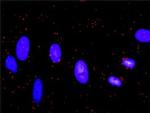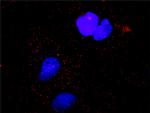Search Thermo Fisher Scientific
FIGURE: 1 / 2
CASP9 Antibody (H00000842-M02) in PLA


Product Details
H00000842-M02
Species Reactivity
Host/Isotype
Class
Type
Clone
Immunogen
Conjugate
Form
Concentration
Purification
Storage buffer
Contains
Storage conditions
Shipping conditions
Product Specific Information
Sequence of this protein is as follows: MDEADRRLLR RCRLRLVEEL QVDQLWDALL SRELFRPHMI EDIQRAGSGS RRDQARQLII DLETRGSQAL PLFISCLEDT GQDMLASFLR TNRQAAKLSK PTLENLTPVV LRPEIRKPEV LRPETPRPVD IGSGGFGDVG ALESLRGNAD LAYILSMEPC GHCLIINNVN FCRESGLRTR TGSNIDCEKL RRRFSSLHFM VEVKGDLTAK KMVLALLELA QQDHGALDCC VVVILSHGCQ ASHLQFPGAV YGTDGCPVSV EKIVNIFNGT SCPSLGGKPK LFFIQACGGE QKDHGFEVAS TSPEDESPGS NPEPDATPFQ EGLRTFDQLD AISSLPTPSD IFVSYSTFPG FVSWRDPKSG SWYVETLDDI FEQWAHSEDL QSLLLRVANA VSVKGIYKQM PGCFNFLRKK LFFKTS
Target Information
Caspase 9 (ICE-like apoptotic protease 6, ICE LAP6, apoptotic protease Mch6, apoptotic protease activating factor 3, Apaf3) is a member of the peptidase family C14 that contains a CARD domain. Caspases are cysteine proteases, expressed as inactive precursors, that mediate apoptosis by proteolysis of specific substrates. Caspase 9 is active as a heterotetramer, is present in the cytosol and, upon activation, translocates to the mitochondria. Caspase 9 is involved in the caspase activation cascade responsible for apoptosis execution and cleaves/activates Caspase 3 and Caspase 6. Further, Caspase 9 is involved in the activation cascade of caspases responsible for apoptosis execution. Binding of caspase-9 to Apaf- 1 leads to activation of the protease which then cleaves and activates caspase-3. Caspase 9 promotes DNA damage-induced apoptosis in a ABL1/c-Abl-dependent manner, and proteolytically cleaves poly(ADP- ribose) polymerase (PARP). Caspase 9 is expressed in variety of human tissues. An isoform of rat Caspase-9 has been identified in which the C terminus of full-length Caspase-9 is replaced with an alternative peptide sequence. Mutations in Caspase 9 affect brain development. In mice, insufficient Caspase 9 have resulted in abnormal cerebrum development and neuron development. In humans, dysfunctional Caspase 9 expression vary from tissue to tissue. Low levels of Caspase 9 may play a role in cancer development and neurodegenerative diseases such as Alzheimer’s Disease (AD).
For Research Use Only. Not for use in diagnostic procedures. Not for resale without express authorization.
References (0)
Bioinformatics
Protein Aliases: APAF-3; apoptotic protease activating factor 3; Apoptotic protease Mch-6; Apoptotic protease-activating factor 3; cas9; CASP 9; CASP-9; caspase 9, apoptosis-related cysteine peptidase; Caspase-9; Caspase-9 precursor; CASPASE-9c; Caspase9; CTD; ICE-LAP6; ICE-like apoptotic protease 6; OTTHUMP00000002324; protein phosphatase 1, regulatory subunit 56; RNCASP9; RP11-265F14.3
Gene Aliases: APAF-3; APAF3; CASP9; ICE-LAP6; MCH6; PPP1R56
UniProt ID: (Human) P55211
Entrez Gene ID: (Human) 842

Performance Guarantee
If an Invitrogen™ antibody doesn't perform as described on our website or datasheet,we'll replace the product at no cost to you, or provide you with a credit for a future purchase.*
Learn more
We're here to help
Get expert recommendations for common problems or connect directly with an on staff expert for technical assistance related to applications, equipment and general product use.
Contact tech support
